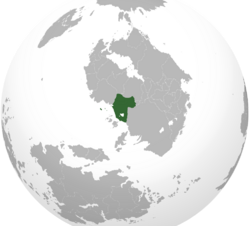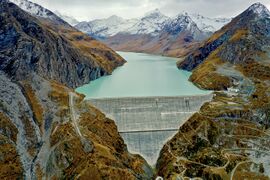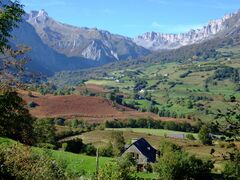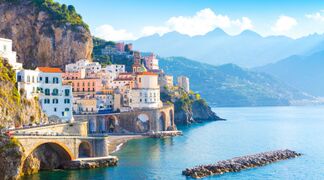Calinthia: Difference between revisions
mNo edit summary |
mNo edit summary |
||
| Line 65: | Line 65: | ||
==History== | ==History== | ||
''What is a general overview of your country's path through history?'' | ''What is a general overview of your country's path through history?'' | ||
=== | ===Early History=== | ||
'' | ''During the time period of Great Levantia, young King Galaecius I (Born 441 AD) at only 16 years of age was tasked with expanding the Empire Westwards across the riverlands. He spent the next 45 years battling against Gothic and Gaelic tribes who lived in the regions. King Galaecius I was able to expand the Empire's borders well past what was expected of him, going all the way to what was then the Western border of Gothica. By 481 AD both the regions of Gothica, and Carna fell under King Galaecius I domain. The Levantian Emperor granted King Galaecius I the title of Gothicus for his conquests, and allow him to rule over the new land as King Galaecius I of Calintia. However, King Gothicus Galaecius I and his armies faced a new threat. Due to their conquest in Grussland and Carna, Gothic barbarians from modern day Yonderre having heard of King Galaecius I began descending on the new found Kingdom of Calintia. Northern raids soon turned into a full fledged invasion, and by 492 AD, most of the Northern region of Calinthia including the modern Shimmering Forests were filled with Gothic war camps. Turning his attention North, King Galaecius I fought the Goths back to the Arathian Pass in what would be known as "The Arathian War (492-493 AD)". The Arathian War was notable for battles taking place in the Shimmering Forest as well as across the Montes Aureos mountain range. The most famous battle was that of the Battle of Arathian Pass in 493 AD. The battle saw King Galaecius I outnumbered 43 to 1 by his Gothic counterpart Will of Wandsberg who was King of the Goths in that region. Despite heavy casualties, King Galaecius I eeked out a pyrrhic victory and managed to kick the Goths out temporarily. King Galaecius I was then granted the title of Restitutor Orbis, or "Restorer of the World". 8 years later, Will of Wandsberg and his son would return to Calintia, and in a series of battles forced King Galaecius I back into the Riverlands. Gothic hordes joined forces with local Gaelic tribes and marched on the Empire's heartland. In 502 AD, Great Levantia collapsed shortly after the barbarian invasions.'' | ||
=== | |||
''The Empire of Calintia was established in 502 AD follwing the collapse of Great Levantia. Overwhelmed by barbarians both Gothic and Gaelic, Emperor Gothicus Galaecius I now age 61 created his Empire to combat the barbaric hordes alone. Emperor Galaecius I managed to retake most of Western Calintia in a series of battles that was known as "The Palantius War", Palantius being the ancient Calintian word for rivers. As the name suggests, the wars took place in the Western Calintian riverlands. The war resulted in many Gaelic and Goth barbarians dead, and a good portion of the land taken in the earlier conquests retaken (although most of the Western lands would remain permanently in Gothic hands).'' | |||
===Republican Period=== | |||
''What were the first political structures of your country? Did it have any very early rivals or was it controlled by a foreign country?'' | ''What were the first political structures of your country? Did it have any very early rivals or was it controlled by a foreign country?'' | ||
=== | ===Modern History=== | ||
''How did the 20th century affect your country?'' | ''How did the 20th century affect your country?'' | ||
==Geography== | ==Geography== | ||
Revision as of 15:45, 27 April 2023
Calinthia ("Kingdom of Calinthia") Regno di Calintia (Calintian) | |
|---|---|
|
Flag | |
Motto: Morte ai traditori! Fedele per sempre! ("Death to traitors! Loyal forever!") | |
Anthem: La morte prima del disonore ("Death Before Dishonor") Royal anthem: Dio è con Costatino ("God Is With Constatine") | |
 Location of Calinthia (dark green) In Levantia (gray) | |
| Capital and largest city | Aurelia |
| Official languages | Calintian Other Romance Languages |
| Religion | Catholic |
| Demonym(s) | Calinthian (noun) Calin (adjective) |
| Government | Absolute Monarchy |
• Queen | Syrilla Constatine II |
• Princess | Decia Constatine I |
• General of the Military | Felicio Franz Sarino |
| Legislature | Constatine Family |
| Royal Family | |
| People's Representatives | |
| Establishment | |
• Decree of King Joraine I | 1593 AD |
| Population | |
• Estimate | 81,000,000 (2025) |
• Census | 79,138,011 (2020) |
| GDP (nominal) | estimate |
• Total | $2.1 Trillion |
• Per capita | $30 700.496 (2020) |
| Currency | Seros (SRS) |
| Driving side | right |
Calinthia, officially the Kingdom of Calinthia, is a country in Levantia. It is neighbored by Yonderre, Urcea, Anglei, Eldmora, and Ardmore. It is the region located within the South-Western portion of the continent of Levantia. It was founded in 1593 AD by King Joraine I. Originally the territory was known as the Western Levantine Kingdom founded in 917 AD, and was a part of the Holy Levantine Empire. In modern times Calinthia is
Etymology
Why is your country called what it is? What is the source of that word or phrase?
The Kingdom of Calinthia
History
What is a general overview of your country's path through history?
Early History
During the time period of Great Levantia, young King Galaecius I (Born 441 AD) at only 16 years of age was tasked with expanding the Empire Westwards across the riverlands. He spent the next 45 years battling against Gothic and Gaelic tribes who lived in the regions. King Galaecius I was able to expand the Empire's borders well past what was expected of him, going all the way to what was then the Western border of Gothica. By 481 AD both the regions of Gothica, and Carna fell under King Galaecius I domain. The Levantian Emperor granted King Galaecius I the title of Gothicus for his conquests, and allow him to rule over the new land as King Galaecius I of Calintia. However, King Gothicus Galaecius I and his armies faced a new threat. Due to their conquest in Grussland and Carna, Gothic barbarians from modern day Yonderre having heard of King Galaecius I began descending on the new found Kingdom of Calintia. Northern raids soon turned into a full fledged invasion, and by 492 AD, most of the Northern region of Calinthia including the modern Shimmering Forests were filled with Gothic war camps. Turning his attention North, King Galaecius I fought the Goths back to the Arathian Pass in what would be known as "The Arathian War (492-493 AD)". The Arathian War was notable for battles taking place in the Shimmering Forest as well as across the Montes Aureos mountain range. The most famous battle was that of the Battle of Arathian Pass in 493 AD. The battle saw King Galaecius I outnumbered 43 to 1 by his Gothic counterpart Will of Wandsberg who was King of the Goths in that region. Despite heavy casualties, King Galaecius I eeked out a pyrrhic victory and managed to kick the Goths out temporarily. King Galaecius I was then granted the title of Restitutor Orbis, or "Restorer of the World". 8 years later, Will of Wandsberg and his son would return to Calintia, and in a series of battles forced King Galaecius I back into the Riverlands. Gothic hordes joined forces with local Gaelic tribes and marched on the Empire's heartland. In 502 AD, Great Levantia collapsed shortly after the barbarian invasions.
The Empire of Calintia was established in 502 AD follwing the collapse of Great Levantia. Overwhelmed by barbarians both Gothic and Gaelic, Emperor Gothicus Galaecius I now age 61 created his Empire to combat the barbaric hordes alone. Emperor Galaecius I managed to retake most of Western Calintia in a series of battles that was known as "The Palantius War", Palantius being the ancient Calintian word for rivers. As the name suggests, the wars took place in the Western Calintian riverlands. The war resulted in many Gaelic and Goth barbarians dead, and a good portion of the land taken in the earlier conquests retaken (although most of the Western lands would remain permanently in Gothic hands).
Republican Period
What were the first political structures of your country? Did it have any very early rivals or was it controlled by a foreign country?
Modern History
How did the 20th century affect your country?
Geography
-
Solasire Dam located in central Calinthia at Lake Syrilla.
-
Castle Albicus located on the North end of Lake Romulus, in the North-West region of Calinthia. (Looking East)
-
A small village in a valley located within the Montes Aureos region.
-
Napolis, the second most populated city in Calinthia.
What is the general explanation of how your country exists within the world?
Climate and environment
Is your country hot or cold?
Government and Politics
How is your country ruled or governed?
Executive and Legislative
As an Absolute Monarchy, the monarchist in charge makes all political, legislative, and military decisions. Since 1999, Queen Syrilla Constatine II is the executive decision maker and Absolute Monarch of Calinthia.
Federal subdivisions
There are multiple counties within Calinthia, all of which owe and have sworn allegiance to the Constatine royal family.
Politics
There are no political factions within the Kingdom of Calinthia. All political decisions are made at the behest of the Queen/monarch.
Law
What kind of laws and legal system does your country employ?
Military
Calinthia has a long historical military tradition dating back to the time of Emperor Galaecius I. The first-born son of every Calinthian family is socially expected to serve for at least several years in the Calinthian Armed Forces. While not a requirement, most feel socially pressured into serving their time, while many more willingly volunteer their time. It's common for a single family to have multiple members serving in the military at any given time.
Demographics
What kind of people live in your country?
Ethnicity
The main ethnic group of Calinthia is Calinthian at 96.3%. Followed up by an Ænglish minority at 2.7%. The remaining 1% is Gaelic people. Calinthian is described as a Latin-Gothic mix. Due to the high intermixing during the existence of the Kingdom of Calinthia, this new admixture of Latin-Gothic peoples came to be referred to simply as 'Calinthian'.
Language
What language or languages do your country's people use? Are there any previously used languages no longer common? Are these languages native to your country or shared with another?
Due to the Anti-Anglei Laws of 1952, any non-Calinthian languages are outlawed in any official capacity. Legal documents, public signs, hand-written notes, and even public speaking must be in Calinthian.
Religion
Due to the Anti-Anglei Laws of 1952, any non-Catholic religions are banned. Any religious practice outside of the Catholic church is illegal. The laws are heavily enforced, with the punishments for breaking the law being life imprisonment to death.
Education
State-Education within Calinthia is enforced. All children age 5-16 years of age are required to attend state-funded schools. After reaching age 16, males are given the option between technical school, university, or military education. Females are given the option between home-education, or military education. University is strictly male only as women are expected to begin raising a family.
Culture and Society
What do your people do, and what are they like?
Education
What is your country's education system like? How do the schools work? What do people think about education?
Attitudes and worldview
Calinthians are extremely devout and religious people. They attend church every Sunday, pray before eating, and wear crosses. The Catholic church plays a large role within the cultural foundations of Calinthia. Thus an attack on Catholicism is viewed as an attack on Calinthia. Many Calinthians are anti-Ænglish, and anti-Protestant. Military expansionism is seen as natural to Calinthians.
Kinship and family
Due to Catholicism playing a large role in the everyday lives of Calinthians, families are no different. The average Calinthian family has around 4 children per household. Having just one child is viewed almost as a cultural taboo. This is taken into consideration when building homes with most houses being built with 5 bedrooms.
Cuisine
What do your people eat?
Religion
Catholicism is extremely rooted within Calinthian culture and way of life. Whether through art, language, politics, military, or even family, the impact of Catholicism is apparent.
Arts and Literature
What type of art do your people make? Do they have a tradition of painted art, well-crafted television shows, or great music?
Sports
Does your country have any major sports leagues? What types of sports are played, both professionally and for fun by your country's people?"
Symbols
Are there any prominent symbols which are well known to represent your country?
Economy and Infrastructure
How does your country's economy work?
Industries and Sectors
What are the largest parts of your economy in terms of what they do?
Currency
What exchange systems are used within your country's economy?
Healthcare
How do people in your country procure medical care? How is it paid for?
Labor
How is labor organized within your country? Are there any social institutions or unions which deal with labor concerns?
Transportation
How do people in your country get around? Is there a major highway system as well as sea- and airports?
Energy
What type of energy keeps your nation going? Are you renewable or use fossil fuels, and if you are renewable, how recently did your country transition?
Technology
How advanced is your country? Is it an innovator, or does it largely import new developments?




